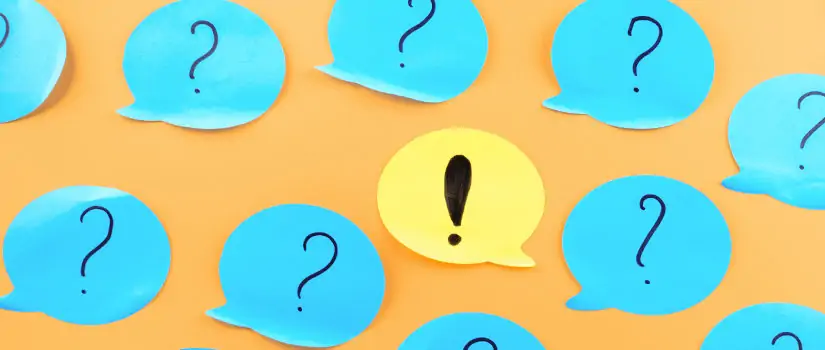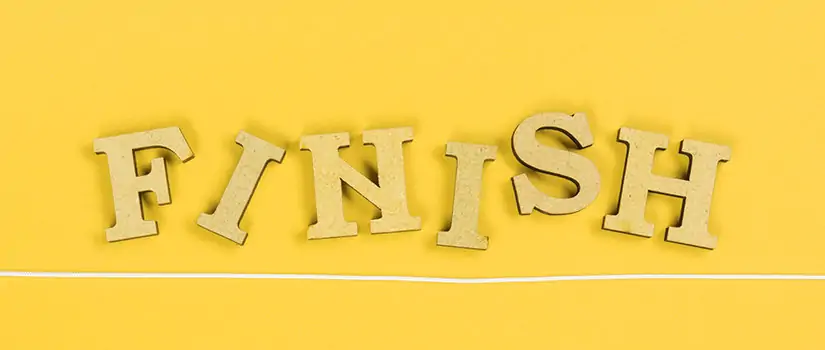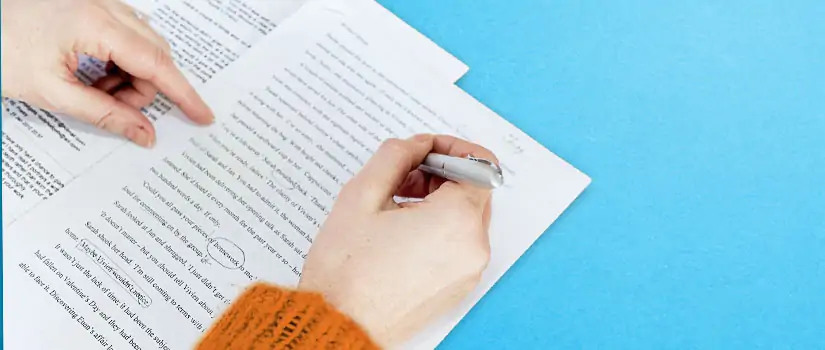
How it’s Possible to Accidentally Plagiarize
We all make mistakes. It’s simply a part of life. One school-related topic that is prone to its fair share of mistakes? Plagiarism. Believe it or not, it’s not hard to mistakenly plagiarize.
Accidental plagiarism is usually the result of being rushed, unorganized, or uninformed about the citation and research process. Whether it’s an accident or an intentional act of plagiarism, the consequences are essentially the same. It can result in a reprimand, failed grade, failed course, or even worse.
There is good news: if you know the causes of accidental plagiarism, you can easily avoid or fix it! Let’s learn three of the most common.
Cause 1:
Dropping research into a document and forgetting you didn't write it
When scouring the Internet for information, most writers copy and paste information into a paper with the intent of citing it properly later. However, after hours and hours of searching and writing, it’s easy to forget that the copy and pasted text isn’t our own work. It can get lost in the shuffle and left without citations.
Fix:
If you’re guilty of this, don’t worry, it’s an easy fix. Always make sure to include in-text or parenthetical citations as you’re working, not after. Cite as you write. That extra minute of adding citations while you’re researching could save your grade.
Cause 2:
Pitiful paraphrasing
Paraphrasing can be your BFF when it comes to writing research papers. But it does require time and effort. You have to think through another person’s idea, then rewrite it in your own words and writing style.
That means doing more than just substituting the original author’s words with synonyms, or chopping up a quote and replacing a small part of it with your own words. Both are mistakes and are considered plagiarism. Sometimes, rewriting an idea into something that is close to the original is also plagiarism.
Bottom line: A poorly written paraphrase results in accidental plagiarism.
Fix:
Here’s a quick how-to guide to creating stellar paraphrases:
1. Read the original author’s idea, quote, or text. Fully grasp the meaning of it. If you’re not grasping the concept, ask a friend for help or use a search engine to read up on the difficult words.
2. After fully comprehending the original author’s information, put it to the side.
3. Write what you read, using your own style and words. It’s okay to take a peek back at the original author’s work, but try to develop your own synopsis!
4. Add an in-text or parenthetical citation, along with a full citation at the end of the project. If you need help formatting your APA citations or MLA citations, check out our fab guides!
Cause 3:
Forgetting to cite
There are so many rules to follow when it comes to research projects. Sources, deadlines, notes, introductions, thesis statements, the list goes on and on. So long in fact that sometimes a pretty important component is forgotten—citations!
Citations should be included in projects anytime another author’s work is referenced. So, if you’re reading through a paper and you come across a statistic, quote, or anything that isn’t common knowledge, a citation should be found nearby. If a piece of information is left hanging, it’s plagiarism.
Mistakes always happen, but when it comes to plagiarism, they’re preventable. Remember to cite as you write, paraphrase properly, and always include citations.
When your research is complete, don’t forget to run your writing assignment through a grammar and plagiarism checker, like the one available with BibMe Plus! This will help ensure that you didn’t miss a citation. You can also check your assignment for grammar errors like a misspelled pronoun, incorrect subject-verb agreement, an uncapitalized proper noun, and more!
...
5 Types of Plagiarism We Forget About
By Michele Kirschenbaum, Library Media Specialist
We’re all responsible researchers, correct? We create perfect APA citations. Our MLA formatting is on point. Chicago style citation? We can do it with our eyes closed. We compose original essays. We’re all amazing writers. We’re...dreaming. You know the saying, if it sounds too good to be true, then it probably is. Let’s face it, writing a research paper is tough. From start to finish, there are a lot of pieces to the puzzle. From note-taking, to finding credible sources, learning how to write an annotated bibliography, citing, formatting, it’s a lot! The pressure of putting together a high-quality paper is stressful and time-consuming, which is why some students feel the need to take shortcuts. Those shortcuts, which at the time may seem like clever hacks, can turn into pretty serious consequences. A disappointing grade, failed course, even expulsion, are just a few of the negative consequences that could happen by taking the easy way out. If it’s your goal to be a responsible researcher (and we sure hope it is!), then it’s important for you to be aware of the various types of plagiarism. Some forms of plagiarism are blatant and obvious. Some are so subtle that you may not even realize they’re forms of plagiarism. We’ve put together a colorful, explanatory infographic that highlights the 5 main types of plagiarism. We even take it a step further and explain how to prevent each type. Read through each form of plagiarism, learn how to prevent it, and feel secure and confident with submitting a paper that is plagiarism-free!
Looking for more resources? Take a peek at the BibMe grammar guides on topics like what’s a conjunction, reflexive vs intensive pronouns, varieties of nouns, and more!
You’ve seen it in the news. A musician accused of stealing a song, a politician’s speech picked apart for being similar to another’s, or a plagiarism inquiry into a well-known scientist’s research report. No doubt, being accused of plagiarism is the worst. It’s embarrassing, totally humiliating, and undermines an individual’s talent and authority.
Learning how to prevent plagiarism (and citing in MLA and APA) is something you’ve probably spent time learning in school before. But, did you know there are a few, often overlooked ways to plagiarize? Check out these three types of plagiarism that tend to sneak into assignments:
Self-plagiarism
You might be shocked when you read this, but you can plagiarize yourself! It sounds crazy, but it’s 100% true. Self-plagiarism is the result of recycling your own material without citing it.
It’s totally tempting to hand in a previously submitted research paper as a “new” project, but doing that means you’re not developing the fresh, current research your teacher expects. Also, if your research paper was picked up by an academic journal for publishing, it can become the property of the journal publication.
Can you reuse projects and information from previously written assignments? You sure can! You simply have to cite it the same way you’d cite other sources. Or, if there’s an old paper that would work perfectly for a new assignment, ask your teacher or professor if you can repurpose it and expand upon it in a new way. If you decide to do this, try out BibMe’s thesis citation form.
Poor paraphrasing or patchwriting
Ever tried rewriting an author’s sentence, but it ended up too close to the original? That’s exactly what patchwriting is. In a nutshell, it’s a poor attempt at paraphrasing. While it’s often an innocent mistake, patchwriting usually happens when a writer doesn’t completely comprehend the original author’s words. The writer uses the original author’s idea, but replaces the original text with synonyms. Even if the writer includes an in-text or parenthetical citation, if the paraphrase is too close to the original, then it’s patchwriting, resulting in plagiarism.
How do you paraphrase properly? Here are a few step-by-step guidelines:
- Take some time to fully comprehend the original author’s words or idea. If you’re having difficulty with comprehension, use a search engine to read up on tricky words or subject-specific language. Sometimes it helps to ask a friend to clarify what you’re reading.
- Once you’ve fully grasped the author’s meaning, put his or her words to the side, and rewrite what you’ve read. Use your own words and style of writing, but weave in the original author’s concepts and ideas.
- Include an in-text or parenthetical citation, along with a full text citation at the end of your project.
Here’s an example of a paraphrase that isn’t patchwriting:
Original text from the book, Libraries in the Ancient World by Lionel Casson:
“The very first problem the Ptolemies faced was acquisitions. Egypt boasted a long and distinguished culture, and there were books aplenty throughout the land—in Egyptian. There were Greek books to be bought in Athens and Rhodes and other established centers of Greek culture, but not in newly fledged Alexandria. The Ptolomies’ solution was money and royal high handedness.”
Paraphrase:
As a new, flourishing cultural center, The Library of Alexandria was in need of rich literature from other prominent areas. Where did the Ptolomies look? Greece. The Ptolomies used their money and power to obtain books from nearby Athens and Rhodes (Casson, 2002, p.34).
Full text citation at the end of the assignment:
Casson, Lionel. Libraries in the Ancient World. Yale UP, 2002, p. 34.
Including full-text citations and forgetting in-text citations
What goes together like peanut butter and jelly? Peas and carrots? Chips and salsa? Let’s give it up for the beautiful duo of in-text and full-text citations. Where there’s one, there has to be the other. Unfortunately, students and scholars sometimes forget to include the total package in their work. Many are guilty of including only full text citations at the end of a project. While that’s helpful, that’s only half the battle.
In-text and parenthetical citations are found in the body of a project, next to a direct quote or paraphrase. They provide readers with a quick glimpse as to who created the original idea, when it was created, and sometimes the page number, depending on the citation style being used. Readers can quickly see the origin of the quote or paraphrased information, and continue reading the research paper, without disturbing the natural flow of the writing.
The in-text citation in the research paper corresponds with the full citation at the end of the assignment.
Here’s an example of an MLA citation in the body of a project :
In the beginning of the novel, the reader is made aware that the father’s business is somewhat corrupt, when young Tabby shares, “Daddy likes to have business talks outdoors, away from prying ears” (Egan 32).
The full MLA citation at the end of the assignment looks like this:
Egan, Jennifer. Manhattan Beach, Simon & Schuster, 2017.
Remember, if you include a full citation at the end of the project, there should be a brief citation in the actual text of the paper. And vice versa. Always include both. Don’t leave one citation without its trusty old friend.
Next time you’re prepping for research paper, keep these pesky plagiarism villains at bay. Being accused of plagiarism is pretty embarrassing, but it’s 100% preventable.
When your research is complete, don’t forget to run your writing assignment through a plagiarism checker, like the one you can find right here on BibMe Plus! This will help you not miss a citation or accidentally pick up text from your research. You can also check your assignment for grammar errors like a misspelled pronoun, incorrect subject-verb agreement, an uncapitalized proper noun, and more!
The Four Kinds of Plagiarism a Plagiarism Checker Can Catch
You’ve probably heard from your teacher that plagiarizing can lead to serious academic consequences. Plagiarism is the act of copying or including information from someone else’s work in your own paper without giving that person proper credit. Thankfully, there are tools available to help you make sure you haven’t committed plagiarism, such as the plagiarism checker located right here on BibMe.
So what kinds of plagiarism can these tools catch? Read on for some details and tips.
1) Copy and pasted sections
Students frequently copy information from an online source and paste it into a draft of their paper. Sometimes this is done on purpose, but it can also be an accident, as the student may just want to use the snippet for organizational or research purposes. The problem is, it becomes very easy to forget to remove, change, or cite sources before handing in the paper. Plagiarism checkers, however, can detect this type of plagiarism, whether it was intentional or not.
2) Uncited quotes
Quotes are frequently used as evidence for an argument in research or literary analysis papers. What can be tricky, however, is remembering to properly cite each quote, no matter how small. It can be easy to forget to write these down, and a plagiarism checker is a great resource to check for any missing citations near quotation marks in your paper.
3) Uncited links
Websites can be great places to start research on a topic, giving you a wealth of information almost instantaneously. Be mindful that you can’t just copy a link into your paper as a reference, however. These do not count as proper citations, and must be formatted correctly in MLA style, APA, or any other format your teacher asks for. Plagiarism checkers can flag these links and suggest that you create a citation for them.
4) Accidental
Not all plagiarism is deliberate. Often students simply forget to include proper citations, or they mistakenly include copied text in their paper. These accidents can unfortunately be very harmful to your grade and academic record. Thankfully, plagiarism checkers can be a second line of defense, along with careful note-taking so you don’t lose track of sources.
Want to check your paper for possible plagiarism? Check out the Plagiarism and Grammar Checker on BibMe! This fantastic tool is a student’s best friend, as it can help to check for instances of plagiarism, provide instant grammar improvement suggestions, and let you add any forgotten citations directly into your paper.
Wrapping up a paper? Try BibMe’s grammar and plagiarism check! ...
5 Ways to Finish a Paper
And they lived happily ever after.
It'd be awesome if all papers could end that simply. However, be it a 500-word essay, a detailed research paper, or a 10-page report, there are a few fundamental rules when finishing a paper. All good conclusions are a summary of the paper’s main points, they never bring in new information, and they always leave the reader with something to think about based on the facts. Papers with the best grades also take it a step further.
For that extra edge, check out our five ideas for finishing a paper. In all our examples, we’ll assume you wrote a paper on the benefits of improving school lunch programs in the United States.
Don’t forget to finish up by proofreading your paper! BibMe Plus offers a handy grammar and spell check (and MLA and APA format citing tools) you can use 24/7.
Quote
You do not have to create every sentence in your paper yourself. In fact, some of the most important information can come from an expert on the subject, a public figure or any individual that plays a strong role in the story you are sharing. Quotes can help you finish with emotion.
Example quote ending:
"We can all agree that in the wealthiest nation on Earth, all children should have the basic nutrition they need to learn and grow and to pursue their dreams, because, in the end, nothing is more important than the health and well-being of our children” (Obama).
If you have a bibliography, add a citation for your quote source. It doesn’t matter if it is in MLA format or another style, it’s a good practice to always create citations for information you’ve used.
Question
If you really want your readers to agree with your ideas, end your paper with a question. The best question allows your readers to think for themselves but also leads them to the conclusion you want.
Example question ending:
If the nutrition and quality of school lunches can be improved without budget increases, is there any good reason for them to remain the same?
Action
You’ve probably seen this type of ending a lot in commercials. Instead of only providing information, you ask your reader to do something. Phrases like: call now, text, and reply are pretty familiar, but any phrase using a command will work.
Example action ending:
Now that you know the benefits of better school lunches, talk to your principal to see what you can do to make a change in your community.
Forecast
Forecast statements usually begin with the words “when” or “if.” This ending allows the writer to present a theory about the future based on the facts discussed in the paper.
Example forecast ending:
When new school lunches are first introduced, it will take a lot of time and effort to see change nationwide, but each school that succeeds will serve as inspiration to the next. One day, lunches of fatty, processed food will be history.
Big picture
Your paper should focus on a very specific subject, but one way to end your work is to give an example of how your topic could impact the larger world around it. When writing this type of ending, you have to be very careful not to introduce entirely new information.
Example big picture ending:
The fight to change school lunches is not only about the daily nutrition of our nation’s children, it is an investment in a healthier America for generations to come.
Now that we’ve taught you a few new ways to end your paper, which will you choose?
Before you begin writing, build up your grammatical knowledge with our guides on different parts of speech. Review our examples of interjections, list of determiners, conjunction definition, and other helpful resources.
...
9 Steps to Writing a Great Research Paper
By Amanda Marie Clark
The research paper can be intimidating for even the most well-seasoned writer. Working on such a big task isn’t exactly what most of us want to do with our out-of-class time. But you can own that process and come out with a paper you're proud of. Let’s break up that research paper into steps and make your life a whole lot easier.
1. Choose a topic
You might think this step is common sense, but sometimes that first step is the hardest. Even if your teacher gives you a general subject or topic, you still need to narrow it down.
For example, say your teacher assigns a research paper on volcanoes, that's a huge topic to cover! Are you looking at why volcanoes erupt? Maybe you’re doing a survey of all the active volcanoes in the world, or are talking about what happens when they die. Obviously, you need to zero in on one thing.
2. Gather sources
So you have a topic. Great! Now it's time to gather all of your sources. Make sure that you diversify. Prime example: try not to have your sources all be websites or all be authored by the same person. Strong research is built upon diverse sources, authors, observations, and experiments all supporting (or disproving) the same concept. Your teacher will thank you.
Aside from just websites, maybe look at a book, a journal article, videos, maps, etc. That will help you build a good basis for an excellent research paper.
Don’t forget: make sure your sources are reliable! Consider the credibility of your sources. That includes factors like credibility, relevance, currency, authority, and purpose.
3. Write the bibliography
Waiting to do your bibliography when you’re at the end of writing your paper seems like a good idea, but actually doing them as you gather sources is the way to go.
Why? Because the last thing you want to do is go back through your paper to identify information you need to cite, while also trying to remember where the information came from. Worse still, if you miss or forget to cite a source, it could be considered (accidental) plagiarism. Yikes!
Whether it be in APA or MLA format, the easier and smarter way is to make your citations from the get-go. Also, doing it at the beginning of a project means you will still have steam to properly format and proofread your paper at the end.
4. Take notes
All right, on to the meaty part. After you have your topic and sources, it's time to roll up your sleeves and start taking notes.
So what's the solution? I found that having a separate page for every source helped. But you might try graphic organizers like T-charts or Cornell notes. Some students also like writing all of their notes with bullets.
There are many approaches to choose from. So once you find a strategy that works for you, go with it.
5. Write your thesis
Some people like writing their thesis right after finding their topic. This helps them set up a research strategy.
Others like writing the thesis after researching and taking notes. The information gathered helps them look at the topic more clearly and puts them in a better-educated place to come up with a thesis.
Either way is fine as long as it works for you. Just remember that a thesis is a crucial element to a research paper and needs to be done before working on your outline.
You can also think about your thesis as you narrow down your topic and begin to research.
Let’s stick with that volcano paper example. You could form a question like: “How are volcanoes formed?” This allows you to research an answer that you can use as the basis of your thesis.
For more information on how to form a thesis read 4 Simple Steps to Writing a Good Thesis Statement.
6. Write an outline
Outlines help a lot! They get your thoughts in order and provide starting points for writing. When you start to expand on them, the ideas should flow.
An outline organizes your thoughts in note formation. Start by brainstorming the main ideas of each paragraph’s topic sentence and then jot down the main ideas around each topic.
There are many ways to create a research paper outline. An easy way to approach one is to use numbers for each of your main paragraphs and letters for specific points within each paragraph.
An outline also breaks down the structure of your paper. So your introduction, body paragraphs, and concluding paragraphs should be in their proper places and good to go.
7. Write a rough draft
Next, sit down and start typing a rough draft based on the outline. The outline is the blueprint to your paper; build out each section based on it. Don't worry too much about punctuation or making total sense, just get some thoughts in full sentences on paper.
Seriously, type and push those thoughts forward while trying not to press backspace.
8. Move on to the second, third...drafts
Now you can get analytical. Go through and start fixing your draft up.
Try to make sure that everything in your paper relates to your thesis. If it doesn't, get rid of it.
Look for concrete details. That means if you made a claim, support it with research.
After looking over your second draft, take a breather. Don't try to correct it again for a little while. Your brain needs a break. Go jogging, do some yoga, watch a movie, or sleep on it (if it's not due the next day). Then go back and reread it.
Repeat this process a couple of times.
Also consider having someone proofread your paper, or even running it through an automated tool like the BibMe Plus grammar checker. It’ll catch the typos and small grammar errors you just didn't see. Then finish off with a lovely typed, final draft.
9. Hand it in with pride
Lastly, hand in that sparkling, finished research paper with pride because you just gave it your all. And I bet you learned a lot about volcanoes too!
Before you begin typing, refresh your grammar knowledge with our guides on relative pronouns, coordinating conjunctions, prepositions, and other parts of speech.
...
How to Use Thanksgiving Break Productively
TGFT: Thank goodness for Thanksgiving! Whether you’re spending your break with friends or family, the time off is a nice respite from school. But between forkfuls of pie, you can actually make great use of your school vacation by getting ahead on schoolwork and even making progress toward securing that summer job/internship—yes, that timeline is sneaking up already.
Here are six things you can do over Thanksgiving break to help you return to class feeling ready to take on finals week and secure the perfect summer internship.
Get ahead on schoolwork
Chances are, you have long-term assignments or projects due sometime after Thanksgiving. Get ahead on work—and save yourself from stress down the line—by using your break to complete these. It could be as small as brainstorming research paper topics, or as consuming as finishing an entire presentation. Just target a few assignments you’d like to work on, and bring your books with you if you’re traveling for the holiday. This way, when finals week comes up, you’ll be able to focus on prepping for exams rather than on finishing projects.
Update your resume
Haven’t had the opportunity to add your fall internship or new leadership position to your resume? Now’s your chance. Summer internship and job opportunities for many fields begin to open up in November—so Thanksgiving marks a great moment to ready your resume for the job search.
Start your summer internship/job search
Thanksgiving is early to start your internship or job search—but it’s not too early. Get ahead of the game by scoping out when your target companies begin their recruiting cycles. Add important dates—like application openings and deadlines—to your calendar, so that you’re able to have everything in before the due date.
Pro tip: Cover letters and writing samples can be time-consuming to craft, and Thanksgiving is a great time to work on them both! If writing isn’t your strong suit, this grammar and plagiarism checker can help review your letter so you send it off with more confidence.
Catch up on missed readings
If you’ve managed to fall behind in any of your classes, it’s not too late to catch up before finals week begins! If you’re leaving school for the holiday, shove those textbooks into your carry-on suitcase or toss them in the backseat of the car before you head out of your dorm room for the break. Take careful notes that will help you when it comes time to study for final exams.
Pro tip: if you’re doing readings for a research paper, start citing sources as you take notes. It’ll make it MUCH easier later when you write your paper and need to create an MLA works cited, an annotated bibliography, or a reference list in APA format or Chicago style format.
Get some extra sleep
Yes, you read that tip right! Feeling tired after completing the majority of the fall semester? Now’s the time to get the sleep you haven’t recouped since midterm season. Try getting a full eight hours of sleep every night during the break—and try to wake up naturally, not from the sound of a buzzing alarm. That way, you’ll go into finals season feeling refreshed, rather than burnt-out.
Take some me-time
Thanksgiving break provides a good time to get ahead for the quickly approaching finals week, but it also marks an opportunity to finally take a breather after making it through the majority of a busy semester. Sprawl out on the couch and watch a few Thanksgiving episodes of “Friends,” or go for a jog in the park. Thanksgiving break is a break, after all, and self-care is important. After completing most of the fall semester, you’ve earned some time for rest and relaxation before hunkering down for finals week.
Want to step up your writing game? Learn more about subject-verb agreement, what a predicate adjective is, how to use demonstrative pronouns, and other grammar points with BibMe’s grammar guides!
...
Bounce Back From a Bad Paper Grade
Nothing’s more frustrating than getting a bad grade on a paper, especially if you thought you nailed it until you saw the offending mark. But if you get a bad grade on a paper, there’s no need to write off the class itself—you can get your overall grade back up with a better performance on the next assignment. Try the tips here to help you bounce back from that bad grade!
Turn your next paper in with more confidence by running it through the BibMe Plus grammar and plagiarism check. It’ll suggest writing edits and flag unintentional plagiarism. You can also start building your grammar knowledge with our guides on pronouns, prepositions, adverbs, and other parts of speech.
1. Don’t Panic
Remember: One bad grade doesn’t define you. It can be difficult to keep a level head after you receive an unfortunate mark, but it’s important to try your best. Take a minute to be upset, and feel free to vent to a friend or family member. However, make sure to take time to cool down so you don’t end up blowing up at your teacher or professor. Try to use that frustration as motivation to do better. Below are a few strategies you can use.2. Read Over the Comments
If your professor or teacher left detailed comments on your paper, don’t ignore them. Read through all of the suggestions carefully so you can get an idea of what needs to be improved. Use those remarks to inform your future writing, and analyze whether there’s a common theme among all of your mistakes.2. Talk to Your Instructor
Getting a bad mark on a paper can be frustrating, but you shouldn’t take out those frustrations on your teacher. Take the time to talk to your teacher and discuss what you did right, what you did wrong, and how you can improve. For subsequent essays, you could meet with your teacher or a teaching assistant in advance to come up with a game plan. If you’re intimidated to speak with your teacher, see if your college has a writing center. A writing center’s main purpose is to effectively help you work on your writing and papers.3. Reflect Upon the Situation
Think back to when you initially wrote the paper, and figure out what went wrong. Did you spend an adequate amount of time on the essay? Did you try writing your paper with the TV blaring? Reflect upon how you ended up writing the essay you wrote, and try to figure out what you can do to improve the writing process.4. Get Some Perspective
For a student who did especially well in high school, a C+ on a research paper might seem like a unsurmountable disappointment. However, it’s important to keep in mind that a C is average. Ask your instructor if there’s a curve for the class.5. Have a Friend Read Over the Next Paper
While you should trust your own instincts when it comes to paper writing, it’s also helpful to have a pal in your class read over your paper before giving it to your instructor for review. If you have a friend who did well on the paper you bombed, ask them if you can read over what they wrote to get a better sense of what your instructor is looking for.6. Pay Mind to Spelling and Grammar
Although spelling and grammar may seem relatively unimportant, they can make a big difference when it comes to your final paper grade. For your next paper, make sure to carefully comb through the essay, and make sure to at least run it through spell check before sending it off.Stressed about creating citations for your paper? BibMe has your back! It’s the APA and MLA citation generator you’ve been looking for. If you need another style like Harvard, Chicago style format, and others, BibMe has thousands of styles to choose from. ...
